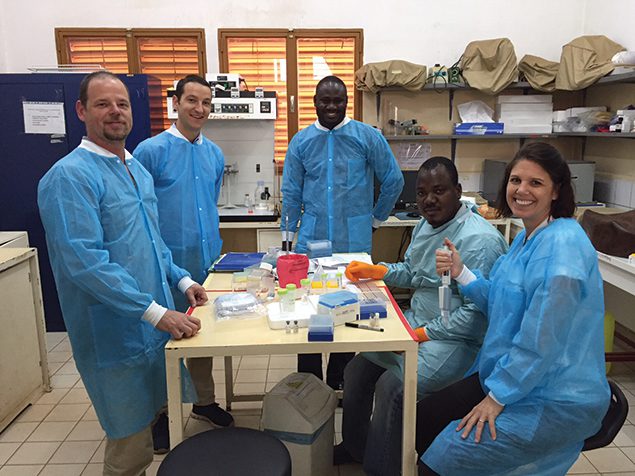Global Health Security Agenda (GHSA) Success Stories
CDC and its partners have made significant progress in strengthening health security capacity in the first years of implementation of the Global Health Security Agenda. In the 17 GHSA priority countries, CDC and its partners have supported activities that translate into faster containment of disease threats.
Containing a deadly outbreak of meningococcal disease to help prevent its spread
In April 2017, Liberia reported 18 cases and 10 deaths from an unidentified illness. Within 24 hours, the country mobilized 14 U.S.-trained Liberian disease detectives, activated its new Public Health EOC, and deployed a national Rapid Response Team. In-country laboratory testing ruled out Ebola within 24 hours, and within days, U.S. laboratories were able to confirm meningococcal disease as the cause of the outbreak. Fast and coordinated response helped limit the outbreak to 31 cases and 13 deaths.
Improving the country’s laboratory testing capacity through hands-on training by CDC experts
In May 2017, Burkina Faso’s National Arbovirus Viral Hemorrhagic Fever Reference Laboratory achieved capacity to test for Lassa fever, Crimean-Congo Hemorrhagic Fever, Rift Valley fever, dengue, chikungunya, and Zika viruses. CDC provided hands-on, practical training in molecular biology and serology testing, virtual technical consultations, and the provision of reagents and equipment. This broader laboratory testing capacity enables more accurate identification and faster containment of infectious disease threats.
Preventing outbreaks of Marburg hemorrhagic fever from becoming regional epidemics
In November 2017, Uganda staged a rapid and effective response when three deadly cases of Marburg hemorrhagic fever, caused by the Marburg virus, were reported. CDC Uganda assisted with tracing, monitoring, and testing of 297 people who had been in contact with sick patients. When one suspected case traveled across the border into Kenya, CDC Kenya supported emergency preparedness activities to prevent a potential outbreak. This outbreak further demonstrated the need for cross-border collaboration and communication to ensure rapid and effective response to disease threats.
Conducting a full-scale exercise to test emergency response systems
In September 2017, the government of Cameroon staged the first large-scale, international public health response exercise in Africa with support from CDC experts, the U.S. Defense Threat Reduction Agency, the World Health Organization, and other partners. The week-long exercise focused on a simulated outbreak of cholera and challenged Cameroon’s outbreak response capabilities, testing the country’s improved laboratories, ability to share information in real time, new Public Health EOC, and other systems.
Enhancing rapid, local detection of infectious disease outbreaks through event-based surveillance
CDC supported an event-based surveillance (EBS) pilot project from 2016-2017, actively engaging local community members, leaders, and health care staff in the detection and reporting of outbreaks. By December 2017, approximately 9,000 people had been trained; they reported more than 5,900 early warning signals of potential outbreaks. Over 420 disease outbreaks were confirmed, including foodborne illnesses; mumps; diphtheria; chickenpox; and hand, foot, and mouth disease, with more than 400 of the confirmed outbreaks responded to in under 48 hours.
Strengthening the country’s medical workforce through biosafety and biosecurity trainings
CDC and local implementing partners conducted biosafety and biosecurity (BSBS) workshops in more than 15 laboratories for 95 people. These workshops provided essential, hands-on training in workplace safety practices and policies, use of preventive measures, and safe use and maintenance of equipment. After BSBS training was completed, the BSBS resource persons implemented these practices and became lead trainers in their respective institutions.
Developing capacity to address the burden of multi-drug resistant tuberculosis
In India, 75% of multi-drug resistant tuberculosis (MDR-TB) cases remain undiagnosed and untreated. CDC helped India implement a successful public-private partnership model that has increased capacity to diagnose, treat, and care for MDR-TB patients through virtual health care communities and telementoring. From July 2016–December 2017, more than 2,000 MDR-TB patients accessed health counselors, with an 83% retention and adherence rate among patients at risk of stopping treatment.
Detecting and controlling vaccine-preventable diseases to save lives
Outbreaks of deadly but vaccine-preventable diseases—like measles, diphtheria, and pertussis—continue to threaten Pakistan’s most vulnerable populations, including children. Disease detectives trained through Pakistan’s CDC-supported Field Epidemiology and Laboratory Training Program (FELTP) conducted field investigations and responses to 194 outbreaks in the country, 94 of which were related to vaccine-preventable diseases. In response to these investigations, health departments vaccinated more than 47,000 children.
Strengthening public health capacities at ports of entry for detection, notification, evaluation, and referral of ill travelers
CDC worked directly with the Tanzania Ministry of Health to strengthen public health capacity at three priority airports and two seaports by developing public health emergency response plans and standard operating procedures for the detection, evaluation, and referral of ill travelers. CDC trainings were conducted at all five ports of entry, and an exercise was conducted to test responder capacity to identify and respond to a public health event. With strong engagement from partners, implementation occurred in less than one year.
Developing capacity to further prevent and control antimicrobial resistance (AMR) in healthcare and community settings
Kenya recognized antimicrobial resistance (AMR) and lapses in infection prevention and control practices (IPC) as major public health problems. CDC helped the Kenya Ministry of Health (MoH) develop a comprehensive national AMR policy, establish an AMR surveillance system with the capacity to identify and report AMR, and build IPC capacity at the MoH and healthcare facility levels. The results of this work will be used by the MoH to further develop national-level policies to improve the prevention of AMR and use of antibiotics in Kenya.
Building laboratory capacity for rabies, anthrax, and brucellosis detection and control
Ethiopia is particularly vulnerable to the effects of zoonotic diseases, especially anthrax, brucellosis, and rabies. CDC provided assistance to build national and regional laboratory capacity to test both human and animal samples and support surveillance systems improvements. CDC also worked with the host government to increase the number of sites for pilot brucellosis prevention and control activities; in addition, Ethiopia has introduced an animal vaccine in high-risk areas.

Burkina Faso improving country’s laboratory testing capacity